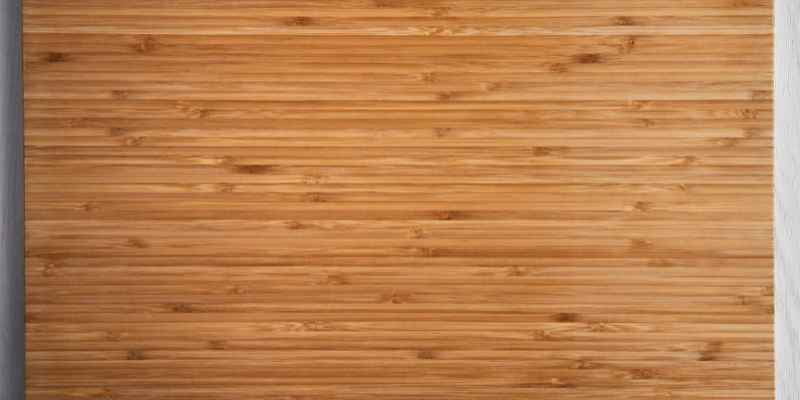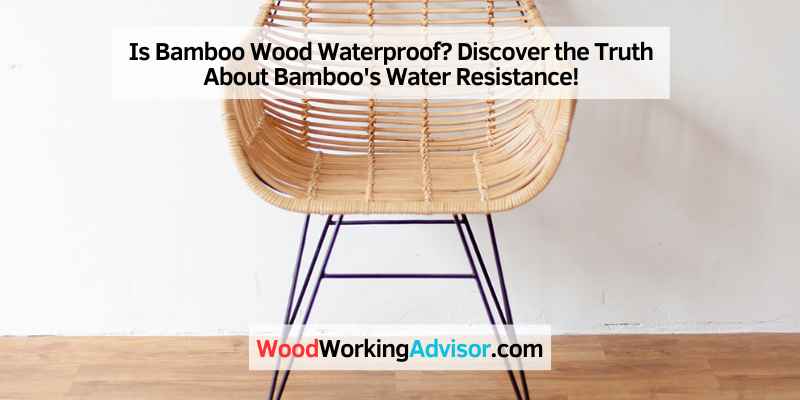Bamboo wood is naturally water-resistant, making it suitable for bathroom use and preventing moisture damage. Bamboo is a versatile and sustainable material known for its strength and flexibility.
Its natural water resistance properties make it ideal for bathroom accessories and other areas prone to moisture exposure. However, despite its water resistance, bamboo is not completely waterproof and may deteriorate over time if not properly maintained. Understanding the unique properties of bamboo can help you make informed decisions when incorporating this eco-friendly material into your living spaces.
Whether it’s for flooring, furniture, or décor, bamboo offers a stylish and durable option with a touch of nature’s resilience.
Properties Of Bamboo
Bamboo is naturally water-resistant, making it ideal for bathroom use. Its inherent properties prevent warping, swelling, and damage from moisture, ensuring durability over time. However, bamboo is not completely waterproof and may need to be treated to enhance water resistance.
Natural Water-resistance
Bamboo is naturally water-resistant, making it a popular choice for various applications. Its inherent properties help prevent warping and swelling when exposed to moisture.
Susceptibility To Moisture Damage
Although bamboo is water-resistant, extended exposure to moisture can lead to damage. High humidity levels and subfloor moisture may cause warping and distortion in bamboo flooring.
Bamboo Vs. Other Wood Types
When comparing bamboo to other wood types, one of the crucial factors to consider is water resistance. Bamboo is naturally water-resistant, which sets it apart from many traditional hardwoods such as oak and maple. This inherent property makes bamboo an excellent choice for areas prone to moisture and humidity, such as bathrooms.
Comparative Water Resistance
Bamboo’s resistance to water is a result of its composition as a grass rather than a traditional wood. The fibers of bamboo are tightly woven together, creating a natural barrier against moisture. This quality helps prevent the material from warping, swelling, or being easily damaged by water, which makes it a durable and long-lasting option for various applications.
However, it’s essential to note that while bamboo is more water-resistant than hardwood, it is not completely waterproof. When exposed to excessive moisture or standing water for extended periods, bamboo can still experience some damage. Therefore, it’s crucial to avoid unnecessarily exposing bamboo to excessive water to maintain its integrity.
Comparatively, traditional hardwoods such as oak and maple are more susceptible to water damage. These types of wood can absorb water, causing them to swell, warp, or even rot over time. This makes bamboo a superior choice in environments where water exposure is a concern.
It’s worth mentioning that various treatments are available to enhance bamboo’s water resistance further. These treatments can include applying sealants or coatings that add an additional layer of protection to the material. However, even with these treatments, bamboo will never reach a completely waterproof state.
In summary, when comparing bamboo to other wood types in terms of water resistance, bamboo stands out as the superior choice. Its natural resistance to water, coupled with its durability and eco-friendly nature, make it an excellent option for those seeking a sustainable and resilient material for their projects.
Use Of Bamboo In Wet Areas
In wet areas, bamboo, being naturally water-resistant, is a suitable choice for bathroom usage. Its properties deter warping and damage from moisture, ensuring longevity and durability for bamboo accessories.
Bathroom And Shower Applications
Bamboo is an ideal material for bathroom and shower applications due to its natural water-resistant properties. Unlike traditional hardwoods like oak and maple, bamboo resists moisture, preventing warping, swelling, and damage over time. This makes it a reliable and durable option for bathroom accessories, flooring, and furniture.
Considerations And Precautions
While bamboo exhibits water resistance, it is important to take certain considerations and precautions when using it in wet areas:
- Ensure proper treatment and maintenance: Bamboo can deteriorate if not properly treated and maintained, making it susceptible to pest attacks and structural weakness.
- Limit exposure to standing water: Although bamboo is water-resistant, extended exposure to standing water can still lead to warping and distortion. Therefore, it is advisable to clean up any spills or standing water promptly.
- Regularly check for signs of moisture damage: High humidity levels and subfloor moisture can contribute to cupping, a concave shape that occurs in bamboo flooring. Regularly check for signs of moisture damage to maintain the integrity of your bamboo surfaces.
Bamboo Treatment For Enhanced Water Resistance
Bamboo, a popular choice for eco-conscious consumers, possesses innate water-resistant qualities, making it ideal for various applications. However, to enhance its resistance further, specific treatments can be applied.
Methods To Increase Water Resistance
- Application of bamboo sealants or finishes
- Utilization of engineered bamboo with enhanced water-resistant properties
- Enhanced manufacturing techniques incorporating water-resistant coatings
Effectiveness And Limitations
While these treatments can boost bamboo’s water resistance, it’s essential to note that complete waterproofing is unattainable. Bamboo’s natural characteristics may limit the extent to which water resistance can be enhanced.
Common Misconceptions About Bamboo’s Water Resistance
Bamboo is naturally water-resistant, making it an ideal material for various uses. Despite its resistance, it’s important to note that bamboo is not completely waterproof and may deteriorate over time if not properly maintained. However, its inherent properties help prevent warping and damage from moisture, making it a favorable option for certain applications.
There are several misconceptions surrounding the water resistance of bamboo wood. Many people believe that bamboo is completely waterproof, while others assume that it can withstand long-term water exposure without any negative effects. However, it is important to understand the reality behind these misconceptions in order to make informed decisions about using bamboo in wet environments.
Complete Waterproofness
Contrary to popular belief, bamboo is not completely waterproof. While it is true that bamboo has natural layers of protection that some hardwoods lack, it is still susceptible to water damage if exposed to moisture for extended periods of time. The water resistance of bamboo can be enhanced through proper treatment, but it will never achieve complete waterproofness.
Long-term Water Exposure Effects
One of the common misconceptions about bamboo is that it can withstand long-term water exposure without any negative effects. However, this is not the case. Extended moisture exposure can cause warping and distortion in bamboo, a phenomenon known as cupping. Cupping occurs when the boards start to concave in the center, and it can be triggered by factors such as spills, high humidity levels, improper acclimation, and subfloor moisture.
It is important to note that not all bamboo products are the same when it comes to water resistance. Some bamboo flooring and bathroom accessories are treated with additional coatings or finishes to enhance their water repellency. Therefore, if you are considering using bamboo in wet areas, it is crucial to choose products specifically designed and treated for water resistance.

Best Practices For Maintaining Bamboo’s Water Resistance
Bamboo wood is naturally water-resistant, making it an ideal material for various applications, including bathroom accessories. Its inherent properties help prevent warping, swelling, and damage from moisture, ensuring long-term durability. However, proper treatment and maintenance are crucial to prevent deterioration and susceptibility to pests.
Cleaning And Maintenance
To preserve bamboo’s water resistance, regular cleaning and maintenance are essential. Use a mild soap
solution or bamboo-specific cleaner and a soft cloth to wipe down bamboo surfaces. Avoid using excess water
or harsh chemicals that can damage the natural water resistance of bamboo.
Preventative Measures
- Place mats or rugs in high-moisture areas to prevent excessive water exposure.
- Avoid leaving wet items on bamboo surfaces for extended periods to prevent warping or damage.
- Apply a bamboo sealant or wax periodically to enhance water resistance.
Frequently Asked Questions Of Is Bamboo Wood Waterproof
Is Bamboo Wood Resistant To Water?
Bamboo wood is naturally water-resistant, ideal for bathroom use, preventing warping, swelling, and moisture damage.
What Are The Disadvantages Of Bamboo Wood?
Bamboo wood has a few disadvantages. It can deteriorate over time if not properly treated and maintained. It is also susceptible to termite and pest attacks, weakening its structure. While it is more water-resistant than other hardwoods, it is not completely waterproof.
Is Bamboo Ok To Get Wet?
Bamboo is naturally water-resistant, making it suitable for bathroom use. It resists warping, swelling, and damage from moisture, ensuring durability. However, it is not completely waterproof. Bamboo can deteriorate if not properly treated and may be susceptible to termite and pest attacks.
What Happens When Bamboo Gets Wet?
Bamboo resists moisture and is durable, but extended wetness can lead to warping and distortion known as cupping.
Conclusion
Bamboo, though not completely waterproof, resists moisture well, making it suitable for certain uses. Safeguarding against warping and damage, bamboo bathroom products stay durable and appealing over time. Consider the advantages and drawbacks before incorporating bamboo into your living spaces for a sustainable touch.

